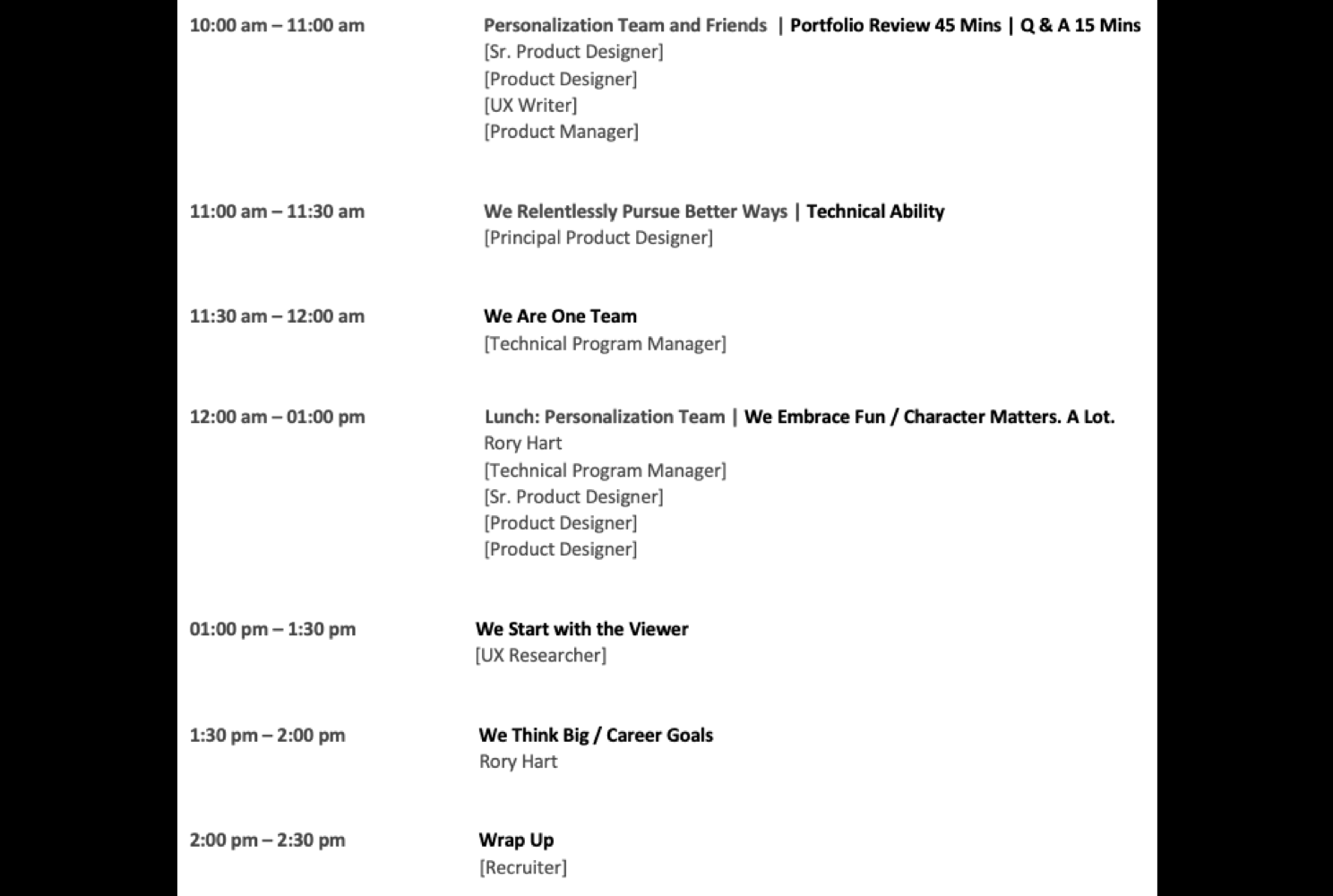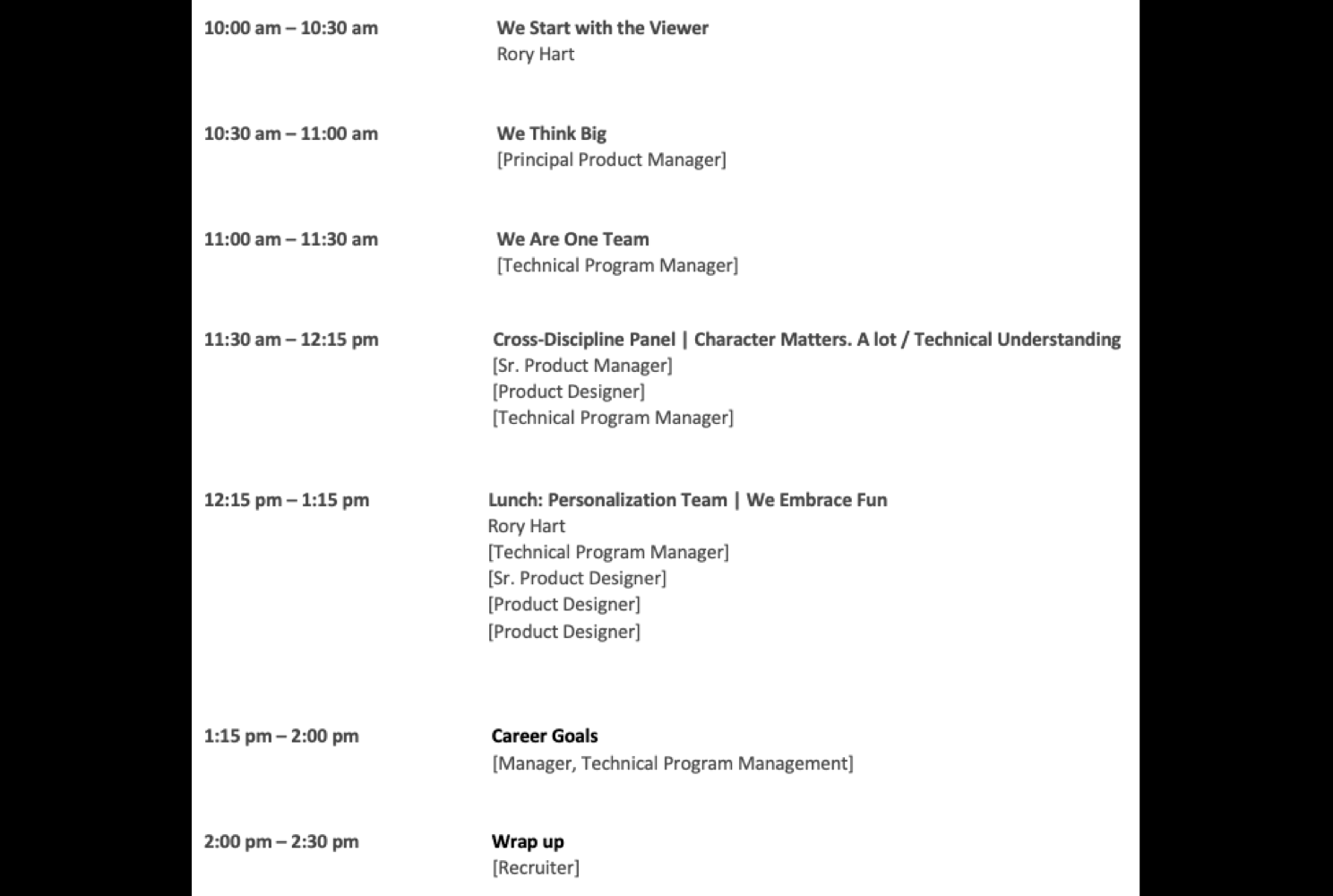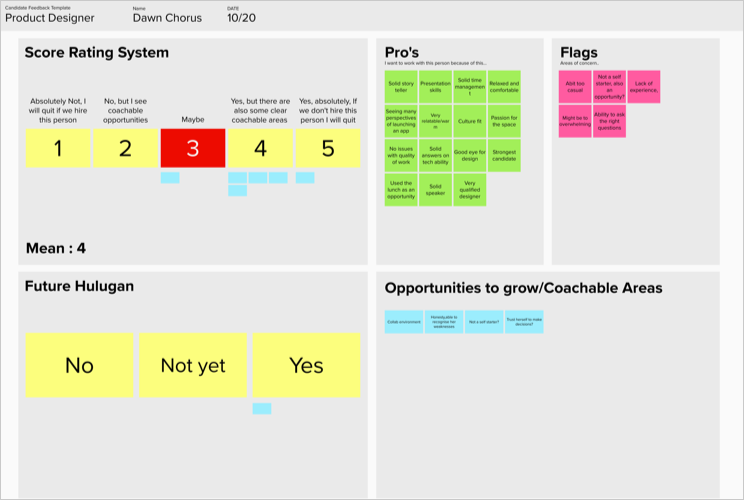Building Product Design Teams
Strategy & collaboration is key
Having to go through several hundred resumes to find the right candidate can seem like a daunting task for any hiring manager.. I’d like to share some thoughts on my experience building a design team
Background
I was given the green light to start hiring designers for the newly formed Personalization Design Team in an effort to support a number of key initiatives either in-flight or upcoming.
The Challenge
With only 2 dedicated designers and a TPM, we were pretty much spread thin with the amount of projects we were handling at the time. Growing the team at the same time was not going easy so we needed to be efficient and work together to bring in the right candidates that not only had the technical ability, but fit the team dynamic and would be solid partners/team players.
What I’m about to share is the approach for how we overcame this challenge in an extremely competitive space and hopefully gives you some pointers on how to hire for multiple roles at the same time when given the opportunity to build a team yourself
Process
Here is an overview of the steps involved to hiring great talent. What I’m about to discuss is what happened in each phase in more detail and some of the challenges we ran into so they can be avoided in the future.
Phase 1 - Team Sync
Meeting Length: 30-45 Minutes
I really can’t stress enough how important this step is in the hiring process. It’s not only an opportunity to plan with your team but really get a sense from everyone on the team what skills, attributes and expertise we might be looking in the candidates. This was an open conversation with myself, the TPM and the designers, I took notes over the course of the meeting to set us up for success for the next step in the process which is all about prepping for candidate conversations via zoom.
What we learned
This was a great way to really understand the types of people we wanted on the team and partnerships we wanted to create between the designers
Phase 2 - Candidate Prep
Portfolio’s Screened: 400
Myself and the team were warned that we will need to be prepared to screen a lot of portfolios based on the positions we were hiring for and the time of year. In an effort to get through the submitted portfolios and narrow down to candidates we were excited about, we needed a document that we could clearly organize, rank, take notes and show status updates of which candidates had been screened vs those who were yet to be. The image below shows the google sheet we used to organize the applicants.
Structure of the spreadsheet leveraging dummy information
What we learned
This was a great way for us to quickly rank portfolios as a team, the designers felt empowered and provided really great feedback on why we should or shouldn’t consider a candidate based on their portfolio. The biggest challenge here was because of the sheer amount of applications, it took countless hours to get a really good sense of each portfolio and decide if the candidate would be considered for a zoom screen.
Phase 3 - Zoom Screen
Length of conversation: 30 Minutes
Initial Process
Being part of previous interview loops for other teams, the one thing I felt i couldn’t get a good read of someone was the phone screen. I typically come off calls still wondering who I just spoke to and left wondering if it would have been more valuable to see the potential candidate face to face to get a better sense of who they and have more of a natural conversation. So with that, I decided to zoom screen the candidates instead. I’m glad I did and heres why:
A much better flow of conversation and a better sense of who they are and what their aspirations and goals are for the future.
A better sense of team dynamic
Once all Calls have taken place and we felt good about the candidate, we would sync with our senior recruiter and confirm date and time for the onsite interview
Room for Improvement
Even though we were getting to speak to more candidates by leveraging zoom,, we still had so many to get candidates we wanted to speak to and portfolios to screen. I asked the designers how they felt about pairing up on calls instead of individually talking to the candidate in an effort for them to get a sense of team dynamic.
Zoom Screen Questions
Having a set of questions on deck really helped shaped the conversations. I had a pretty good idea of what I wanted to discuss which helped the conversation feel natural and not sounding like a robot. This was a face to face conversation after all so I would just go with the flow of the conversation but making sure I hit on all the points I wanted to get to to help partly inform my decision to move forward with the candidate or not.
Below are some of the key questions I would ask during our conversation:
Tell me a bit about yourself?
Why Hulu? What attracted you to apply for this position
What do you value in this field of work?
What are you passionate about in this field of work?
What’s the biggest challenge you’ve faced in your current role? Tell me about it.
What questions can I answer for you?
What we learned
We got a much better understanding of the candidate during the face to face zoom calls
Group calls were also well received and gave a sense of the candidate/team dynamic
Scheduling calls were sometimes difficult based on availability
30 minutes isn’t a long time when talking to candidates so we would focus on a few questions to get a sense of their soft/hard skills.
Phase 4 - Decide On Candidates For In-Person Interviews
Regroup With Recruiter and Team: 30-45 Minutes
Each of us took notes immediately after each call so we could come to the meeting and discuss each conversation and make a decision on who we would like to bring in for the interview.
What we learned
Leveraging the more streamlined process, we were able to make relatively quick decisions on who we wanted to bring in. Because we all had that face to face time we got a much better read of the candidates skills on both the hard and soft side. It’s not a perfect solution, but we believe it to be much more effective than just a phone call
Phase 5 - Interview Loop Preparation
Time for Prep: This can take a while.. Several hours!!
Applying Hulu values
For the In-Person interview, it’s extremely important that you are able to learn as much about the candidate as possible. After confirming with a number of team members that they would be part of the loop, I tasked each one with focusing on a particular Hulu value. I did this in an effort to dig deep into a number of key areas and to make sure we all were not asking the same questions
What we learned
Providing each interviewer with a Hulu value, gave a sense of focus and loose guidance of what types of questions to ask. We did discuss in brief what areas they should focus on and what they thought would be good to understand to provide as much value as possible in the regroup but again, this was something I left to the interviewer to determine.
Phase 6 - Interview Loop
Time: 10am - 2:30pm (4.5 Hours total)
I won’t name names here, but I once had a particularly bad experience interviewing for a pretty well established company. From being flown in on the same morning to interview at 8:30am, meaning I had to get up at 3am to make sure I was able to the the 6am flight, through to eating lunch on my own in the same room I would be staying in till 5:30pm. When I started thinking about how I was going to set up the loop, I thought back to all the things that I documented about that interview experience and wanted to make sure I didn’t replicate their methods for our candidates. So with that said, here is a sample schedule for one of my interview loops.


As you can see I like to start this interview loop at 10am. It gives the candidate time in the morning to prepare for the day and not feel rushed getting to the interview during rush hour in LA traffic. One observation starting at this time was that not one candidate was late or had issues getting to the interview.
Other teams are starting to adapt this process too, we actually used the same approach to hire our TPM. The general methods/phases are the same, but the questions and the agenda are slightly different to accommodate the specific role.
What we learned
Interviews ran smoothly and the general feedback from candidates at the end of the Interview were positively received.
Team lunch with the candidate was a really great way to not only learn more about them in a more relaxed setting, but for the candidate to learn more about the team they would be potentially being part of if hired. This is something I highly recommend.
Portfolio reviews with a small group were extremely effective. We made sure the panel wasn’t just made up of designers but from other disciplines to make sure that the questions about the candidates work were varied.
Having back up team members who will be available to fill in if there is a last minute cancellation is really important. We ran into situations where we would have to shift around the team members or bring in someone last minute due to illness or unforeseen circumstances
Phase 6 - Post Interview Feedback
Try to gather feedback within 2 days of the interview
Providing The Right Feedback
In an effort to keep the feedback concise and organized, we leveraged 4 questions for each team member to answer based on their experience with the candidate. This feedback would ultimately set up the conversation for the debrief in the next phase of the process, the debrief. Here are the follow up questions:
When speaking to [Candidate], I didn’t see any red flags in these categories:
[Candidate] will be successful at Hulu if:
[Candidate] will not be successful at Hulu if:
Other Pros:
What we learned
It was really important that we focus on the positives here, we bring in candidates because we want to hire them, we’re excited to learn about the individuals and what value they will bring to the immediate team and the organization. The whole point of this process was for us to get to this point so we should be in a much better position to receive detailed feedback for these specific questions.
Phase 7 - Debrief
Time needed: 45-60 Minutes
Collaborative Decision Making
The challenge here was that I needed to create an effective way to get strong understanding of the candidate from everyone who interviewed in that particular loop within a 60 minute time frame. I created a candidate feedback canvas in Mural in an effort to guide the conversation and get as much feedback as possible to help inform my ultimate decision to make an offer.
Dummy Information
The Canvas
I broke the canvas into 5 sections; Rating system, Pro’s and Flags, Opportunities to grow/coachable areas and future Hulugan. Being able to show the canvas on the tv with everyone in the room set the stage for the meeting. The only section that needed somewhat of an explanation was the first exercise which was giving the candidate a score based on 1 to 5, then adding up the scores to find the mean number. 3.5 and above would be considered for the role and an offer. Below is the scale of how we rated the candidates
1 - I will quit if we hire this person (This hasn’t happened yet)
2 - No, but is coachable
3 - Maybe
4 - Yes, but there are clear areas to work on
5 - Yes absolutely, I will quit of we don’t hire this person
What we learned
Hold the session a day or 2 after the interview while the candidate is fresh in peoples minds was the best way to receive detailed feedback on specific conversations.
During the first exercise, make sure to have everyone come to the meeting with a score in mind and to have everyone share that score at the same time before going into each interviewers feedback. I found this works better than going around the table one by one in order because I would see people who would come later changing their initial number as their were being influenced by the person/s before them.
Phase 8 - Submit Offer to Candidate
Be prepared for negotiation
If your strategy is sound, and you were able to gather all the necessary information to move forward, then you should be in a better position to make a realistic offer for the candidate that reflects the value we believe they will bring to the company, their experience, skills and areas of expertise.
Reflection
Having a hiring strategy like this in place not only allows you to be effective in seeking out the right candidates much quicker, but also provides an organized, well structured experience for the candidate. I started to receive emails and thank you letters, (even donuts) from candidates sharing how they had such a great experience interviewing with the different teams and getting to know everyone. To be honest, that’s all I was hoping for. If I’m excited about a candidate and we make an offer, I want to make sure they get to know the team, have a sense of the design culture we have created and most of all, accept the offer.
For this post in particular, I wanted to focus more on the strategy and the phases involved in hiring designers for awareness more than what we actually look for in each candidate as that is a post in itself and there is so much to unpack there and so many ways to evaluate. This is more about taking your evaluation techniques and applying to to an overarching hiring strategy.
Finding designers who you believe will thrive on your team is the best way to not only set you up for success (as a manager/leader) but will have a much larger impact on the immediate team, supporting other teams to make better design decisions and evangelize design thinking and the value of it throughout the company.
Lastly, I also realized that this process could easily be adapted to remote hiring based on the collaborative process and the tools used. For the the in-person interview, you could quite easily run the interview loop on zoom as it’s a series of conversations. I haven’t tried this myself yet but the way things are at the moment, I may not have another choice given the opportunity to hire more people.
To be continued..
In part 2 of the Design Management Operations Series, I’m going to talk about onboarding candidates, building relationships, 1:1’s and talk about the career canvas (Shown Below).













